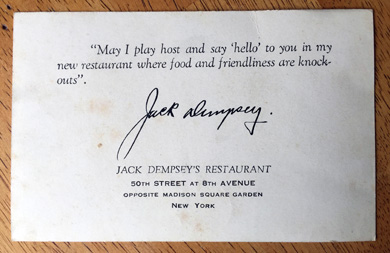 |
|
|||
 |
 |
|||
Copyright © Harry Rinker, LLC 2015 Questions
and Answers
QUESTION: I have a vintage Hubley P-38 toy airplane. It is metal with rubber wheels and retractable landing gear. The nose wheel is missing. The wingspan measures 12 inches. “HUBLEY” is stamped on the wing. The red paint is in fair condition. Do you have any idea what it is worth? – DA, State College, PA, Email Question
ANSWER: The Lockheed P-38 Lightning used by the Army Air Corps (there was no US Air Force at the time) was one of the most famous plane types used during World War II. The P-38’s unique look resulted from two twin boom sections, each with an engine, and central tank-like section that contained the cockpit and armament. The P-38 was heavily used in the Pacific Theater of Operations and the China-Burma-India theaters. John Hubley incorporated the Hubley Manufacturing Company, located in Lancaster, Pennsylvania, in 1894. Hubley made its first toys in 1909. Initially a manufacturer of cast iron toys, Hubley began shifting to die cast, using mazac (a zinc alloy), copying a manufacturing process introduced by Tootsietoy in the early 1930s. In 1965, the Lido Toy Company acquired Hubley. Metals were required for the war effort from1941 to 1945. Hubley did not produce toys of famous World War II planes, such as the Curtis-P20 Warhawk and the Lockheed P-38 Lightning, until after the war. Hubley kept the toy airplanes in production through the early 1960s. Hubley produced several color variations of the Lockheed P-38. The solid “red” color scheme appears to be from the late 1940s and early 1950s. Reviewing the variety of color schemes offered for sale on eBay, it appears some sellers are offering examples that have been repainted with color schemes not used by Hubley. The example with a silver body, red cockpit, and in a box with the label “A MIGHTY-METAL TOY” appears to be from the late 1950s or early 1960s. Toy collectors are extremely fussy about condition. An internet search or a visit to the Allentown (PA) Toy Show, held annually in early November at the Allentown Fairgrounds, should result in finding a replacement wheel. I do not recommend that you consider repainting your plane. This should be done only by a professional toy restorer. Based on the illustrations that were attached to your email, I grade your Hubley P-38 between C4 and C5 condition. It shows signs of heavy play use. As it stands, its value is between $20.00 and $25.00. Restored to like new condition, its value will exceed $100.00. QUESTION: I have a framed Pabst beer advertisement that appeared in the August 12, 1934 “The American Weekly”. The advertisement measures 13 inches by 20 inches. The image has two sketches. The first features a man sitting at his office desk phoning his wife. The second shows the man at home enjoying a glass of Pabst beer and relaxing with his wife. The advertisement is in full color. What do I have and what is it worth? – L, Reading, PA ANSWER: “The American Weekly” was a Hearst Corporation weekly Sunday newspaper supplement. It first appeared on November 1, 1896, and continued until 1966. At the height of its popularity, it enjoyed a circulation of more than 50 million readers. Unlike today’s “Parade Magazine” established in 1941 and distributed by more than 700 newspapers, “The American Weekly” featured sensational content—murder, suspense, and showgirls wearing the barest minimum. “The American Weekly” measured 15 inches x 22 inches, which suggests your advertisement may be trimmed. Page count varied from 12 to 24 pages. Many famous illustrators produced cover art. The list includes Howard Chandler Christy, Henry Clive, James Montgomery Flagg, Erté, and Russell Patterson. Advertisements in the magazine feature artwork by N. C. Wyeth, Rose O’Neill, and Norman Rockwell. You have a tear sheet, a page, usually featuring an advertisement that is torn from a magazine and sold framed or unframed. Unframed common tear sheets sell for between $2.00 and $5.00. Value rests largely with crossover collectors, individuals interested in the theme of the advertisement as opposed to the magazine. Numerous examples of “The American Weekly Magazine” are offered for sale on eBay.com. Complete copies without a famous cover illustrator sell for $10.00 or less. An example with five or more full-page, color advertisements makes cutting it apart for the advertising tear sheets a smart move. If the cover is by a famous illustrator, the price triples. These magazines are likely to stay intact. Of course, when the advertising tear sheet is framed, the value is enhanced. In many cases, the final perceived value is in excess of the cost of the tear sheet, matting, and framing. Your Pabst beer advertisement, provided it is matted and backed with acid free material and framed, has a value between $25.00 and $35.00.
ANSWER: I appreciate the 13 images attached to your email. The image of the side of the valve contained the serial number 162,612. The website www.conn-selmer.com contains a list of serial numbers and their corresponding dates. Consulting the chart entitled “Cup Mouthpiece Instruments 1901-1930,” your euphonium was made in 1918. 1918 began with serial number 155,000. 1919 began with serial number 165, 900. Assuming the numbers were assigned in consecutive order, your euphonium actually was made in the latter half of 1918.
Charles Gerard Conn patented a rubber-rimmed mouthpiece for brass instruments in 1875. Partnering with Eugene Victor Baptiste Dupont, a brass instrument maker, Conn started selling a Four-In-One cornet, the first brass musical instrument from Conn & Dupont in 1876. Conn & Dupont dissolved in 1879. By 1905, Conn had the largest musical instrument factory in the United States. In 1915, a group of investors led by Carol Dimond Greenleaf bought Conn’s holdings. Greenleaf served as president from 1915 to 1949. For a detailed history, see: https://en.wikipedia.org/wiki/C.G._Conn. If I interpret the photographs correctly, the instrument is in poor condition. The brass plating is pitted and missing in some areas. The instrument needs to be re-plated. It is not clear if the instrument is playable. Do the adjustment values and the finger values work? It is clear there are issues with the mother-of-pearl on the top of the values. At this point, you have what is affectionately known in the antiques and collectibles trade as a “wall hanger.” Its real value is how great it looks hanging on a wall. Not restored, the instrument has no playable or historic value. A price of $25.00 will sell your euphonium quickly. A buyer might take a chance at $50.00. If you price it above $50.00, you will be selling it for scrap metal at the end of your rummage sale.
ANSWER: Jack Dempsey’s Broadway Restaurant, not to be confused with the current Jack Dempsey’s located at 36 West 33rd Street in New York, was located between 49th and 50th Streets on Broadway in Manhattan. This was the restaurant’s second location. Jack Dempsey’s Restaurant’s first location was on Eighth Avenue and 50th Street, across the street from the third Madison Square Garden. The restaurant opened in 1935. William Harrison “Jack” Dempsey was born in Manassa, Colorado, on June 25, 1895. He died in New York City on May 31, 1983. Dempsey held the World Heavyweight Championship from 1919 to 1926. He fought 83 times – 65 wins (51 by knockouts), 6 losses, 11 draws, and 1 no contest. His nicknames were “Kid Blackie” and “The Manassa Mauler.” Dempsey was extremely personable. He often greeted diners at his restaurant, posed for pictures, and signed autographs. I have a Jack Dempsey signed menu for his Broadway Restaurant in my collection. Jack Dempsey’s Broadway Restaurant was located next door to the “Turf Restaurant,” owned by Jack Amiel. In the mid-1950s, Amiel became a co-owner of the Jack Dempsey’s Broadway Restaurant. The Dempsey restaurant closed in 1974. Assuming the Dempsey signature on your business card is printed, the value of your card is between $15.00 and $20.00.
Harry L. Rinker welcomes questions from readers about
collectibles, those mass-produced items from the twentieth and twenty-first centuries.
Selected letters will be answered in this column.
Harry cannot provide personal answers.
Photos and other material submitted cannot be
returned.
Send your questions to: Rinker on Collectibles, 5955 Mill
Point Court SE, Kentwood, MI 49512.
You also can e-mail your questions to
harrylrinker@aol.com.
Only e-mails containing a full name and mailing address
will be considered.
You can listen
and participate in
WHATCHA GOT?, Harry’s
antiques and collectibles radio call-in show, on Sunday mornings between 8:00 AM
and 10:00 AM Eastern Time.
If you
cannot find it on a station in your area,
WHATCHA GOT?
streams live on the Internet at www.gcnlive.com.
SELL, KEEP OR TOSS?: HOW TO DOWNSIZE A HOME,
SETTLE AN ESTATE, AND APPRAISE PERSONAL PROPERTY
(House of Collectibles, an imprint of Random House Information Group, $17.99),
Harry’s latest book, is available at your favorite bookstore and via
www.harryrinker.com.
|
||||
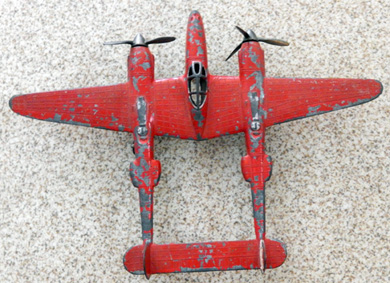
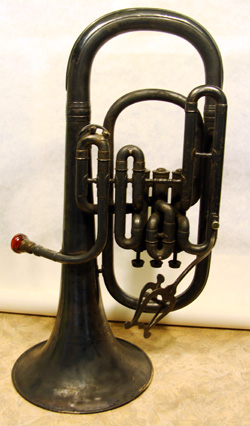 QUESTION: The church group in charge of our annual rummage sale received the donation of a euphonium made by the C. G. Conn Company, Elkhart, Indiana. The carrying case that accompanied it is in poor condition. The group thinks it dates from 1883. Can you help? – A, Altoona, PA, Email Question
QUESTION: The church group in charge of our annual rummage sale received the donation of a euphonium made by the C. G. Conn Company, Elkhart, Indiana. The carrying case that accompanied it is in poor condition. The group thinks it dates from 1883. Can you help? – A, Altoona, PA, Email Question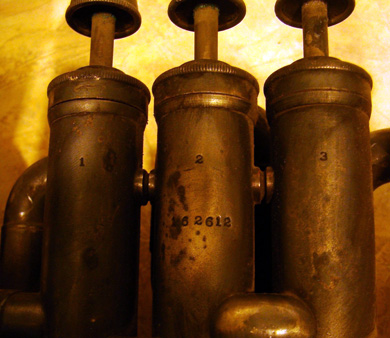
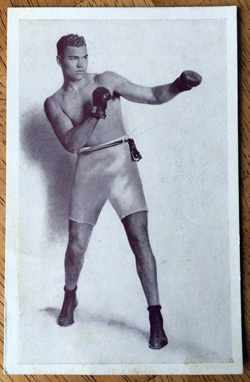 QUESTION: I found a card that has a picture of Jack Dempsey, the former heavyweight boxing champion, on one side and this quote on the back: “May I play host and say hello to you in my new restaurant where food and friendliness are knockouts.” A printed Dempsey signature and the restaurant’s name and address are also part of the card. I would like to know if it is worth anything. – DN, Forest Hill, MD, Email request.
QUESTION: I found a card that has a picture of Jack Dempsey, the former heavyweight boxing champion, on one side and this quote on the back: “May I play host and say hello to you in my new restaurant where food and friendliness are knockouts.” A printed Dempsey signature and the restaurant’s name and address are also part of the card. I would like to know if it is worth anything. – DN, Forest Hill, MD, Email request.